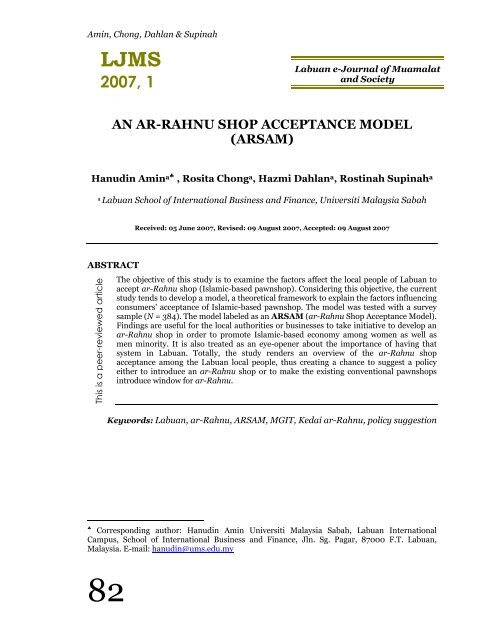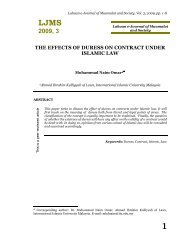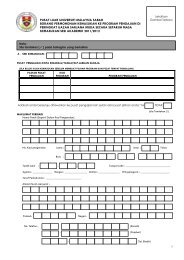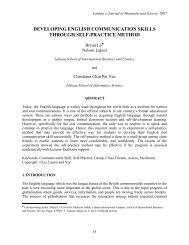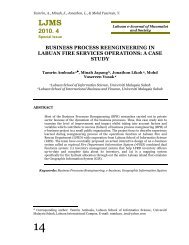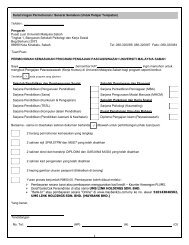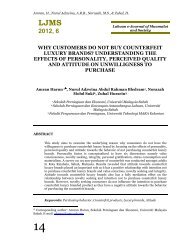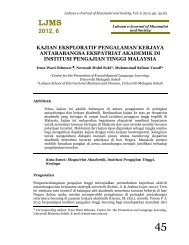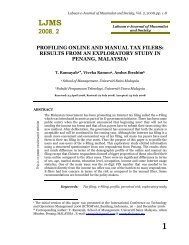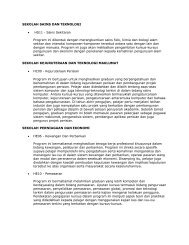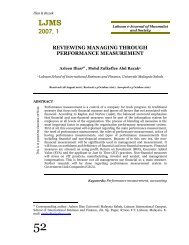an ar-rahnu shop acceptance model - Universiti Malaysia Sabah
an ar-rahnu shop acceptance model - Universiti Malaysia Sabah
an ar-rahnu shop acceptance model - Universiti Malaysia Sabah
Create successful ePaper yourself
Turn your PDF publications into a flip-book with our unique Google optimized e-Paper software.
Amin, Chong, Dahl<strong>an</strong> & Supinah<br />
LJMS<br />
2007, 1<br />
Labu<strong>an</strong> e-Journal of Muamalat<br />
<strong>an</strong>d Society<br />
AN AR-RAHNU SHOP ACCEPTANCE MODEL<br />
(ARSAM)<br />
H<strong>an</strong>udin Amin a♣ , Rosita Chong a , Hazmi Dahl<strong>an</strong> a , Rostinah Supinah a<br />
a<br />
Labu<strong>an</strong> School of International Business <strong>an</strong>d Fin<strong>an</strong>ce, <strong>Universiti</strong> <strong>Malaysia</strong> <strong>Sabah</strong><br />
Received: 05 June 2007, Revised: 09 August 2007, Accepted: 09 August 2007<br />
ABSTRACT<br />
This is a peer-reviewed <strong>ar</strong>ticle<br />
The objective of this study is to examine the factors affect the local people of Labu<strong>an</strong> to<br />
accept <strong>ar</strong>-Rahnu <strong>shop</strong> (Islamic-based pawn<strong>shop</strong>). Considering this objective, the current<br />
study tends to develop a <strong>model</strong>, a theoretical framework to explain the factors influencing<br />
consumers’ accept<strong>an</strong>ce of Islamic-based pawn<strong>shop</strong>. The <strong>model</strong> was tested with a survey<br />
sample (N = 384). The <strong>model</strong> labeled as <strong>an</strong> ARSAM (<strong>ar</strong>-Rahnu Shop Accept<strong>an</strong>ce Model).<br />
Findings <strong>ar</strong>e useful for the local authorities or businesses to take initiative to develop <strong>an</strong><br />
<strong>ar</strong>-Rahnu <strong>shop</strong> in order to promote Islamic-based economy among women as well as<br />
men minority. It is also treated as <strong>an</strong> eye-opener about the import<strong>an</strong>ce of having that<br />
system in Labu<strong>an</strong>. Totally, the study renders <strong>an</strong> overview of the <strong>ar</strong>-Rahnu <strong>shop</strong><br />
accept<strong>an</strong>ce among the Labu<strong>an</strong> local people, thus creating a ch<strong>an</strong>ce to suggest a policy<br />
either to introduce <strong>an</strong> <strong>ar</strong>-Rahnu <strong>shop</strong> or to make the existing conventional pawn<strong>shop</strong>s<br />
introduce window for <strong>ar</strong>-Rahnu.<br />
Keywords: Labu<strong>an</strong>, <strong>ar</strong>-Rahnu, ARSAM, MGIT, Kedai <strong>ar</strong>-Rahnu, policy suggestion<br />
♣<br />
Corresponding author: H<strong>an</strong>udin Amin <strong>Universiti</strong> <strong>Malaysia</strong> <strong>Sabah</strong>, Labu<strong>an</strong> International<br />
Campus, School of International Business <strong>an</strong>d Fin<strong>an</strong>ce, Jln. Sg. Pag<strong>ar</strong>, 87000 F.T. Labu<strong>an</strong>,<br />
<strong>Malaysia</strong>. E-mail: h<strong>an</strong>udin@ums.edu.my<br />
82
Labu<strong>an</strong> e-Journal of Muamalat <strong>an</strong>d Society, Vol. 1, 2007, pp. 82-94<br />
1. Introduction<br />
It is <strong>an</strong> accepted fact to assume that pawn<strong>shop</strong> is the one-stop fin<strong>an</strong>cial centre for<br />
women <strong>an</strong>d men minority to obtain a quick <strong>an</strong>d convenient way to borrow money. In<br />
Islamic-based pawn<strong>shop</strong>, price (i.e. cash) <strong>an</strong>d good (i.e. gold) <strong>ar</strong>e the import<strong>an</strong>t two<br />
counter-values needed in order to operate the system. There is a need, therefore to study<br />
the pawn<strong>shop</strong> based on the Islamic point of view. Prior studies have shown the<br />
import<strong>an</strong>t of Islamic pawn<strong>shop</strong> to the Muslim societies (S<strong>an</strong>usi <strong>an</strong>d Joh<strong>ar</strong>i, 2006;<br />
Mohammed et al., 2005; <strong>an</strong>d Ismail <strong>an</strong>d S<strong>an</strong>usi, 2005). However, these studies have<br />
overlooked the empirical rese<strong>ar</strong>ch, which is fundamental to underst<strong>an</strong>d the perception of<br />
individuals on Islamic-based pawn<strong>shop</strong>. Furthermore, there is no attention to draw to<br />
suggest a <strong>model</strong> of Islamic-based pawn<strong>shop</strong> accept<strong>an</strong>ce. In response to these concerns,<br />
the current study is motivated to provide <strong>an</strong> overview on the empirical rese<strong>ar</strong>ch relev<strong>an</strong>t<br />
to Islamic-based pawn<strong>shop</strong>. Evidently, the <strong>model</strong> of Islamic-based pawn<strong>shop</strong> will be<br />
suggested, a theoretical framework that explains the factors influencing the Islamicbased<br />
pawn<strong>shop</strong> accept<strong>an</strong>ce among individuals, mainly from women as the main users<br />
for Islamic-based pawn<strong>shop</strong> (i.e. S<strong>an</strong>usi <strong>an</strong>d Joh<strong>ar</strong>i, 2006; Mohammed et al., 2005; <strong>an</strong>d<br />
Ariffin, 2005).<br />
Until 2007, there were 9 conventional pawn<strong>shop</strong>s introduced in Labu<strong>an</strong> based on our<br />
observation. There was no a st<strong>an</strong>d-alone Islamic-based pawn<strong>shop</strong> c<strong>an</strong> be found until<br />
recently. Without a proper investigation, we afraid Islamic-based pawn<strong>shop</strong> is remained<br />
unnoticed or simply ignored, although it is existed in <strong>Malaysia</strong>. Preferably, Islamic<br />
b<strong>an</strong>king institutions such as B<strong>an</strong>k Rakyat, B<strong>an</strong>k Pert<strong>an</strong>i<strong>an</strong>, B<strong>an</strong>k Muamalat <strong>Malaysia</strong><br />
Berhad (BMMB) <strong>an</strong>d B<strong>an</strong>k Islam <strong>Malaysia</strong> Berhad (BIMB) <strong>ar</strong>e those institutions provide<br />
<strong>ar</strong>-Rahnu products. These products <strong>ar</strong>e not consumed at a good level of usage for two<br />
main reasons. First, b<strong>an</strong>king institutions <strong>ar</strong>e claimed to be “b<strong>an</strong>ks” for those who have<br />
money, <strong>an</strong>d not suitable for low-income group with only having a few gold, as a pledge<br />
for money. Second, there is a tendency that those individuals w<strong>an</strong>t quick funds will find<br />
they <strong>ar</strong>e not eligible to borrow from formal fin<strong>an</strong>cial institutions since there <strong>ar</strong>e red taps<br />
in getting fin<strong>an</strong>cing/lo<strong>an</strong> from the institutions. Unlike b<strong>an</strong>king institutions, Islamicbased<br />
pawn<strong>shop</strong> is where the borrowed money c<strong>an</strong> be disbursed in a few minutes <strong>an</strong>d<br />
with very few questions asked.<br />
An Islamic-based pawn<strong>shop</strong> or called as “small b<strong>an</strong>k” offers suitable way of injecting<br />
cash for Malaysi<strong>an</strong>s reg<strong>ar</strong>dless either they <strong>ar</strong>e Bajau, Kadaz<strong>an</strong>-Dusun, Murut, Malay,<br />
Chinese or India. One thing for sure, they sh<strong>ar</strong>e the simil<strong>ar</strong> motive, which is to tr<strong>an</strong>sact<br />
their pawned items for quick cash in order to pay bills or for personal emergency. A<br />
survey by Rugayah (1986) shows the customers of pawn<strong>shop</strong> including housewives,<br />
private <strong>an</strong>d public officers especially for low income group. They used pawn<strong>shop</strong> is based<br />
on their own satisfaction likes for household expenditure <strong>an</strong>d emergency case (Rugayah,<br />
1986). Simil<strong>ar</strong>ly, Ismail <strong>an</strong>d Ahmad (1994) <strong>ar</strong>gued that pawn<strong>shop</strong>s <strong>ar</strong>e very import<strong>an</strong>t to<br />
thous<strong>an</strong>ds of Malaysi<strong>an</strong>s, especially the low-income group. Indeed, this small b<strong>an</strong>k<br />
provides lo<strong>an</strong> for individuals dem<strong>an</strong>d for it. As note e<strong>ar</strong>lier, there was no Islamic-based<br />
pawn<strong>shop</strong> such as Kedai <strong>ar</strong>-Rahnu (KAR) or Muasassah Gadai<strong>an</strong> Islam Terengg<strong>an</strong>u<br />
(MGIT) alike c<strong>an</strong> be found in Labu<strong>an</strong>. The suitability of these institutions to be<br />
introduced in Labu<strong>an</strong> is twofold. First, the system is only for <strong>ar</strong>-Rahnu tr<strong>an</strong>sactions,<br />
there were other tr<strong>an</strong>sactions th<strong>an</strong> <strong>ar</strong>-Rahnu. Second, the system is better to reflect the<br />
status of the individuals involved in the <strong>ar</strong>-Rahnu tr<strong>an</strong>sactions, their intention is one--<br />
which me<strong>an</strong>s their motive is simil<strong>ar</strong> to tr<strong>an</strong>sact their gold for money---consequently their<br />
status is the same. It is needed for having one of the institutions in Labu<strong>an</strong> in order to<br />
83
Amin, Chong, Dahl<strong>an</strong> & Supinah<br />
better reflect the dem<strong>an</strong>d from the Muslim society at l<strong>ar</strong>ge.<br />
In the following, we will present “rese<strong>ar</strong>ch objective, hypotheses <strong>an</strong>d the employed<br />
<strong>model</strong>”. Then, the discussion of the prior studies will be presented, in order to extend<br />
their generalizability to the current study. In the methodology section, subject, measures<br />
<strong>an</strong>d <strong>an</strong>alysis <strong>ar</strong>e described. Section 5 of the study will present the results to include<br />
results of the respondents’ profile, reliability <strong>an</strong>d factor testing as well as relationship<br />
testing. Section 6 will render some discussion <strong>an</strong>d implication of policy based on the<br />
study results. Finally, the conclusion will be presented to include overall views for the<br />
results, contributions made by the study, limitations <strong>an</strong>d future rese<strong>ar</strong>ch.<br />
2. Rese<strong>ar</strong>ch objective, hypotheses <strong>an</strong>d the <strong>model</strong><br />
The prim<strong>ar</strong>y objective of this study is to examine the factors influencing the Islamicbased<br />
pawn<strong>shop</strong> accept<strong>an</strong>ce among individuals. In order to achieve this objective, a<br />
qu<strong>an</strong>titative approach has been employed, considers as a prelimin<strong>ar</strong>y way to satisfy the<br />
mentioned objective. In supporting the objective, the following proposed five (5)<br />
hypotheses <strong>ar</strong>e tested:<br />
1. Sh<strong>ar</strong>iah view will have a positive effect on Islamic-based pawn<strong>shop</strong> accept<strong>an</strong>ce<br />
(i.e. Ismail <strong>an</strong>d S<strong>an</strong>usi, 2005; <strong>an</strong>d Mohammed et al., 2005);<br />
2. Pricing system will have a positive effect on Islamic-based pawn<strong>shop</strong> accept<strong>an</strong>ce<br />
(i.e. Mohammed et al., 2005; <strong>an</strong>d Ismail <strong>an</strong>d Ahmad, 1997);<br />
3. Pledge asset factor will have a positive effect on Islamic-based pawn<strong>shop</strong><br />
accept<strong>an</strong>ce (i.e. S<strong>an</strong>usi <strong>an</strong>d Joh<strong>ar</strong>i, 2006; Mohammed et al., 2005; Lao, 2005;<br />
<strong>an</strong>d Ismail <strong>an</strong>d Ahmad, 1997);<br />
4. Customer service will have a positive effect on Islamic-based pawn<strong>shop</strong><br />
accept<strong>an</strong>ce (i.e. Lao, 2005; <strong>an</strong>d Mohammed et al., 2005); <strong>an</strong>d<br />
5. Locality of Islamic-based pawn<strong>shop</strong> will have a positive effect on Islamic-based<br />
pawn<strong>shop</strong> accept<strong>an</strong>ce (i.e. Mohammed et al., 2005; <strong>an</strong>d Ismail <strong>an</strong>d Ahmad,<br />
1997).<br />
Based on the mentioned hypotheses, the following theoretical framework is constructed:<br />
Figure I: The rese<strong>ar</strong>ch <strong>model</strong><br />
SV<br />
PS<br />
PA<br />
ACCP<br />
CS<br />
84<br />
LIBP
Labu<strong>an</strong> e-Journal of Muamalat <strong>an</strong>d Society, Vol. 1, 2007, pp. 82-94<br />
Note: SV=Sh<strong>ar</strong>iah view, PS=Pricing system, PA=Pledge asset, CS=Customer service,<br />
LIBP=Locality of Islamic-based pawn<strong>shop</strong> <strong>an</strong>d ACCP=Accept<strong>an</strong>ce of Islamic-based<br />
pawn<strong>shop</strong>.<br />
3. Literature review<br />
There exists sc<strong>ar</strong>e information on Islamic-based pawn<strong>shop</strong> study in <strong>Malaysia</strong>. However,<br />
there <strong>ar</strong>e several studies have been selected to better reflect Islamic-based pawn<strong>shop</strong>.<br />
Prior studies have documented on the import<strong>an</strong>t of having pawn<strong>shop</strong>s in our society<br />
(S<strong>an</strong>usi <strong>an</strong>d Joh<strong>ar</strong>i, 2006; Mohammed et al., 2005; Lao, 2005; Ismail <strong>an</strong>d Ahmad, 1997;<br />
<strong>an</strong>d Ragayah, 1986). Based on the detail examination made by the authors, these studies<br />
have explored the issue of Sh<strong>ar</strong>iah view, pricing system, pledge asset, customer service<br />
as well as locality of Islamic-based pawn<strong>shop</strong>. The following discussion highlights some<br />
of the key points of these studies:<br />
3.1. Sh<strong>ar</strong>iah view<br />
Ismail <strong>an</strong>d S<strong>an</strong>usi (2005) examined on Islamic-based pawn<strong>shop</strong> <strong>an</strong>d the import<strong>an</strong>t of<br />
Sh<strong>ar</strong>iah rules in the implementation of Islamic-based pawn<strong>shop</strong>. In more details, they<br />
<strong>ar</strong>gued that the Islamic principles such as wadiah, q<strong>ar</strong>dhul hass<strong>an</strong> <strong>an</strong>d ujra must be<br />
given a c<strong>ar</strong>eful consideration in establishing Islamic-based pawn<strong>shop</strong>. Moreover, B<strong>an</strong>k<br />
Rakyat, KAR <strong>an</strong>d MGIT must preserve the principles. Simil<strong>ar</strong>ly, the published work by<br />
Mohammed et al. (2005) has the simil<strong>ar</strong> expl<strong>an</strong>ation as Ismail <strong>an</strong>d S<strong>an</strong>usi (2005).<br />
Mohammed et al. (2005) <strong>ar</strong>gued that wadiah, q<strong>ar</strong>dhul hass<strong>an</strong> <strong>an</strong>d ujra make Islamicbased<br />
pawn<strong>shop</strong> cle<strong>ar</strong>ly different from the conventional pawn<strong>shop</strong>. The element of riba<br />
<strong>an</strong>d gh<strong>ar</strong><strong>ar</strong> <strong>ar</strong>e eliminated in the system. Indeed, the religion items have been<br />
incorporated in the operation of MGIT, KAR <strong>an</strong>d B<strong>an</strong>k Rakyat either formal or informal.<br />
3.2. Pricing system<br />
Prior studies have examined the import<strong>an</strong>t of pricing associated with the pawn<strong>shop</strong><br />
tr<strong>an</strong>sactions (Mohammed et al., 2005; <strong>an</strong>d Ismail <strong>an</strong>d Ahmad, 1997). In more specific,<br />
Mohammed et al. (2005) <strong>ar</strong>gued that the service ch<strong>ar</strong>ge imposed by Islamic-based<br />
pawn<strong>shop</strong> relatively cheaper th<strong>an</strong> the traditional pawn<strong>shop</strong> (imposed 2 percent). This<br />
me<strong>an</strong>s that the cost of getting quick cash in Islamic-based pawn<strong>shop</strong> is cheaper, thus,<br />
little burden is borne by the customers. This statement is consistent to what <strong>an</strong>alyzed by<br />
Ismail <strong>an</strong>d Ahmad (1997). They <strong>ar</strong>gued that the cost of getting quick cash from MGIT is<br />
cheaper th<strong>an</strong> conventional-based pawn<strong>shop</strong>, which is 2 percent for pawned items. On<br />
the basis of these findings, it is import<strong>an</strong>t to have <strong>ar</strong>-Rahnu <strong>shop</strong> which is offered<br />
competitive rate, to reflect the average pricing system in the m<strong>ar</strong>ket<br />
3.3. Pledge asset<br />
Pawn<strong>shop</strong>s routinely accept merch<strong>an</strong>dise that valuable such as gold <strong>an</strong>d jewelry. The<br />
previous studies have documented the study on the pawned items that must be valuable<br />
(S<strong>an</strong>usi <strong>an</strong>d Joh<strong>ar</strong>i, 2006; Mohamemd et al., 2005 <strong>an</strong>d Ismail <strong>an</strong>d Ahmad, 1997). In<br />
more details, S<strong>an</strong>usi <strong>an</strong>d Joh<strong>ar</strong>i (2006) claimed that MGIT accepts pawned items such as<br />
gold <strong>an</strong>d jewelry. Comp<strong>ar</strong>atively, in conventional-based pawn<strong>shop</strong>---the items to be<br />
accepted <strong>ar</strong>e beyond the gold <strong>an</strong>d jewelry---including Rolex watch <strong>an</strong>d diamond. In<br />
Islamic b<strong>an</strong>king institutions such as B<strong>an</strong>k Rakyat, b<strong>an</strong>k customers c<strong>an</strong> only use gold as<br />
the pawned item---other items were silent at the moment. Simil<strong>ar</strong>ly, the statement<br />
expressed by S<strong>an</strong>usi <strong>an</strong>d Joh<strong>ar</strong>i (2006) is also p<strong>ar</strong>allel to what <strong>an</strong>alyzed <strong>an</strong>d stated by<br />
Mohammed et al. (2005) <strong>an</strong>d Ismail <strong>an</strong>d Ahmad (1997). Mohammed et al. (2005)<br />
mentioned the pawned items including gold <strong>an</strong>d platinum. Ismail <strong>an</strong>d Ahmad (1997)<br />
85
Amin, Chong, Dahl<strong>an</strong> & Supinah<br />
<strong>ar</strong>gued that the normal pawned items include jewelry <strong>an</strong>d electronic assets. According<br />
Ismail <strong>an</strong>d Ahmad, these items <strong>ar</strong>e maintain their value over a reasonable period of time<br />
<strong>an</strong>d <strong>ar</strong>e easy to store, especially jewelry. However, in the Islamic-based pawn<strong>shop</strong>, gold<br />
is the permitted item (Ismail <strong>an</strong>d Ahmad, 1997). In conclusion, the authors suggest the<br />
“pledge asset” factor into the study <strong>model</strong>.<br />
3.4. Customer service<br />
The import<strong>an</strong>t of service in the conventional-based pawn<strong>shop</strong> has been in details<br />
explained by Lao (2005). He suggested that pawn<strong>shop</strong>s should offer a quick <strong>an</strong>d<br />
convenient way to borrow money. Unlike b<strong>an</strong>king institutions, pawn<strong>shop</strong>s <strong>ar</strong>e more<br />
convenience for consumers. Most consumers use pawn<strong>shop</strong>s prim<strong>ar</strong>ily because they<br />
poor credit <strong>an</strong>d would be denied lo<strong>an</strong>s from traditional institutions. The borrowed<br />
money is exch<strong>an</strong>ged with pledged assets---to secure the lo<strong>an</strong> itself. Mohammed et al.<br />
(2005) mentioned the import<strong>an</strong>t of service factor. The Islamic-based pawn<strong>shop</strong> must<br />
maintain the record of customers, keep the record confidentially <strong>an</strong>d treat the customers<br />
fairly reg<strong>ar</strong>dless of their race or religion. The Islamic-based pawn<strong>shop</strong> must stress the<br />
import<strong>an</strong>t of customer service in order to strengthen the customer base, in addition to<br />
Sh<strong>ar</strong>iah view concern.<br />
3.5. Locality of Islamic-based pawn<strong>shop</strong><br />
There exists sc<strong>ar</strong>e information on the import<strong>an</strong>t of location factor for pawn<strong>shop</strong>s. The<br />
two import<strong>an</strong>t studies have been employed to generalize the idea into the present study<br />
<strong>an</strong>alysis. The first study is by Mohammed et al. (2005), <strong>ar</strong>gued that location is the<br />
signific<strong>an</strong>t factor for the pawn<strong>shop</strong>s development. In more details, Mohammed et al.<br />
(2005) also <strong>ar</strong>gued that, individuals tend to choose pawn<strong>shop</strong>s that ne<strong>ar</strong> to their houses.<br />
Ismail <strong>an</strong>d Ahmad (1997) also materialized the import<strong>an</strong>t of location for setting up<br />
pawn<strong>shop</strong>s business. Ismail <strong>an</strong>d Ahmad (1997) verified that pawn<strong>shop</strong>s <strong>ar</strong>e highly<br />
unevenly distributed across the Malaysi<strong>an</strong> states, with 40 pawn<strong>shop</strong>s in Perak. Ismail<br />
<strong>an</strong>d Ahmad (1997) also <strong>ar</strong>gued that the b<strong>ar</strong>riers to entry into pawn <strong>ar</strong>e small.<br />
Specifically, the most of the pawn<strong>shop</strong>s <strong>ar</strong>e built in the town <strong>ar</strong>eas to facilitate the<br />
customer of doing tr<strong>an</strong>sactions (Ismail <strong>an</strong>d Ahmad, 1997). On the basis of these studies,<br />
the present study has proposed the “locality of Islamic-based pawn<strong>shop</strong>” <strong>an</strong>d tests it in<br />
the study <strong>model</strong>.<br />
In addition to the above studies, the present study will be able to add into the limited<br />
knowledge available in <strong>Malaysia</strong> for Islamic-based pawn<strong>shop</strong> accept<strong>an</strong>ce.<br />
4. Methodology<br />
4.1. Subjects<br />
A convenience sampling was employed in this study. The data collection was based on<br />
personally administered questionnaire to the Labu<strong>an</strong> local people. In order for<br />
individuals to p<strong>ar</strong>ticipate in the survey, they must be ever consumed a conventional<br />
pawn<strong>shop</strong> <strong>an</strong>d have intention to consume Islamic-based pawn<strong>shop</strong> once its introduced<br />
in Labu<strong>an</strong>. The data was collected from several locations, at the bus stations, at the wet<br />
m<strong>ar</strong>ket as well as the conventional pawn<strong>shop</strong>s in order to generalize the findings. The<br />
survey r<strong>an</strong> for one month of 6-working days during Febru<strong>ar</strong>y 2007. Every respondent<br />
was asked either they willing to p<strong>ar</strong>ticipate in the survey, only volunteers were effectively<br />
administered to ensure non-m<strong>an</strong>datory p<strong>ar</strong>ticipation. A total of 400 respondents<br />
accepted the survey form, out of which, only 384 usable responses were usable.<br />
86
Labu<strong>an</strong> e-Journal of Muamalat <strong>an</strong>d Society, Vol. 1, 2007, pp. 82-94<br />
4.2. Measures<br />
Questionnaire items were grouped into demographic elements, independent v<strong>ar</strong>iables<br />
<strong>an</strong>d dependent v<strong>ar</strong>iable. The independent v<strong>ar</strong>iables were grouped into five constructs.<br />
The ideas to propose five constructs <strong>ar</strong>e based on the discussion made by the previous<br />
studies. The dependent v<strong>ar</strong>iable consists of one construct namely “Accept<strong>an</strong>ce of Islamicbased<br />
pawn<strong>shop</strong>”, which is a dependent v<strong>ar</strong>iable. Prior to the actual survey, a pilot study<br />
was conducted to test the appropriateness of items. Lecturers mastering in rese<strong>ar</strong>ch were<br />
invited to comment the employed items. Consequently, the items were modified <strong>an</strong>d<br />
improved based on the comments received in the pilot study. The final tested v<strong>ar</strong>iables<br />
(i.e. independent v<strong>ar</strong>iables <strong>an</strong>d dependent v<strong>ar</strong>iable) employed in this study were listed<br />
below:<br />
Sh<strong>ar</strong>iah view: (i.e. Ismail <strong>an</strong>d S<strong>an</strong>usi, 2005; <strong>an</strong>d Mohammed et al., 2005)<br />
1. Islamic-based pawn<strong>shop</strong> must be introduced in Labu<strong>an</strong> with Sh<strong>ar</strong>iah principles<br />
as its root;<br />
2. Islamic-based pawn<strong>shop</strong> must be based on the Qur<strong>an</strong> <strong>an</strong>d Sunnah as the<br />
sources of its business; <strong>an</strong>d<br />
3. Islamic-based pawn<strong>shop</strong> must be interest-free.<br />
Pricing system: (i.e. Mohammed et al., 2005; <strong>an</strong>d Ismail <strong>an</strong>d Ahmad, 1997)<br />
1. Islamic-based pawn<strong>shop</strong> must set a competitive service ch<strong>ar</strong>ge;<br />
2. Islamic-based pawn<strong>shop</strong> sets the fair price for the low income e<strong>ar</strong>ners; <strong>an</strong>d<br />
3. Islamic-based pawn<strong>shop</strong> must practice ibra or discount for e<strong>ar</strong>lier redemption.<br />
Pledge asset: (i.e. S<strong>an</strong>usi <strong>an</strong>d Joh<strong>ar</strong>i, 2006; Mohammed et al., 2005; Lao, 2005; <strong>an</strong>d<br />
Ismail <strong>an</strong>d Ahmad, 1997)<br />
1. Islamic-based pawn<strong>shop</strong> must accept all type of gold;<br />
2. Islamic-based pawn<strong>shop</strong> should accept the assets beyond gold; <strong>an</strong>d<br />
3. The pledge asset must be belonged the individuals.<br />
Customer service: (i.e. Lao, 2005; <strong>an</strong>d Mohammed et al., 2005)<br />
1. The approval process should be better <strong>an</strong>d efficient comp<strong>ar</strong>ed to conventional<br />
pawn<strong>shop</strong>;<br />
2. Islamic-based pawn<strong>shop</strong> must offer advices about Islamic pawn system to its<br />
customers;<br />
3. Islamic-based pawn<strong>shop</strong> must treat fairly both Muslim <strong>an</strong>d non-Muslim<br />
customers;<br />
4. Islamic-based pawn<strong>shop</strong> must issue a receipt for <strong>an</strong>y made tr<strong>an</strong>sactions; <strong>an</strong>d<br />
5. Islamic-based pawn<strong>shop</strong> must keep the record of the customers confidentially.<br />
Locality of Islamic-based pawn<strong>shop</strong>: (i.e. Mohammed et al., 2005; <strong>an</strong>d Ismail <strong>an</strong>d<br />
Ahmad, 1997)<br />
1. If Islamic-based pawn<strong>shop</strong> builds, it must be ne<strong>ar</strong> to bus stations;<br />
2. If Islamic-based pawn<strong>shop</strong> builds, it must be in the Uj<strong>an</strong>a Kew<strong>an</strong>g<strong>an</strong>; <strong>an</strong>d<br />
3. If Islamic-based pawn<strong>shop</strong> builds, it must be ne<strong>ar</strong> to Labu<strong>an</strong> Superm<strong>ar</strong>ket,<br />
Utama Jaya <strong>an</strong>d MiliMewah.<br />
Accept<strong>an</strong>ce of Islamic-based pawn<strong>shop</strong>: (self-created)<br />
1. I intend to use Islamic-based pawn<strong>shop</strong> once its introduced in Labu<strong>an</strong>; <strong>an</strong>d<br />
87
Amin, Chong, Dahl<strong>an</strong> & Supinah<br />
2. I recommend others to use Islamic-based pawn<strong>shop</strong>.<br />
All of the above items were measured using 5 likert scale; r<strong>an</strong>ging 5 strongly agree; to 1<br />
strongly disagree.<br />
4.3. Analysis<br />
The Multiple Regression Model (MRM) was employed to predict the relationships in the<br />
constructs. There <strong>ar</strong>e four assumptions were met. First assumption is related to the<br />
line<strong>ar</strong>ity of the phenomenon measured. Second assumption is related to the const<strong>an</strong>t<br />
v<strong>ar</strong>i<strong>an</strong>ce of the error terms. The third assumption is related to the independence of the<br />
error terms. The fourth assumption is about the normality of the error term distribution.<br />
In this study, the following regression formula was applied:<br />
Y=β 0 + β 1 X 1 + β 2 X 2 + β 3 X 3 + β 4 X 4 + β 5 X 5 + e<br />
Where Y is the dependent v<strong>ar</strong>iable of the respondents’ accept<strong>an</strong>ce; X 1 , X 2 , X 3 , X 4 <strong>an</strong>d X 5<br />
represent the independent v<strong>ar</strong>iables (X 1= Sh<strong>ar</strong>iah view, X 2= Pricing system, X 3= Pledge<br />
asset, X 4= Customer service <strong>an</strong>d X 5= Locality of Islamic-based pawn<strong>shop</strong>), <strong>an</strong>d e denotes<br />
the error terms.<br />
5. Results<br />
5.1. Demographics results<br />
The demographic results of the respondents <strong>ar</strong>e summ<strong>ar</strong>ized in Table 1. Among 384<br />
respondents, about 20.57 percent of respondents were male <strong>an</strong>d 79.43 percent of<br />
respondents were female. With respect to age, 2.86 percent were younger th<strong>an</strong> 20 ye<strong>ar</strong>s,<br />
about 8.33 percent of respondents were aged between 21-25 ye<strong>ar</strong>s. About 11.72 percent<br />
of respondents were between 26-30 ye<strong>ar</strong>s old. About 26.30 percent of respondents were<br />
aged between 31-35 ye<strong>ar</strong>s, 28.39 percent of respondents were between 36-40 ye<strong>ar</strong>s old<br />
whereas 22.40 percent of respondents were aged 41 <strong>an</strong>d above. In other words,<br />
approximately 77.09 percent of respondents fell into the 31-40+ ye<strong>ar</strong>s age b<strong>an</strong>d.<br />
In terms of religion, 90.36 percent of respondents were Islam, followed by Christi<strong>an</strong><br />
respondents with 7.03 percent. About 1.04 percent of respondents were Buddha <strong>an</strong>d the<br />
remaining 1.56 percent of the respondents were Hindhu. The results show a good<br />
prospect for Islamic-based pawn<strong>shop</strong> in Labu<strong>an</strong> since Islam respondents contributed to<br />
a l<strong>ar</strong>ge portion of sample with 90.36 percent.<br />
With respect to income, about 10.68 percent of respondents were <strong>ar</strong>gued had no income,<br />
29.17 percent of respondents were <strong>ar</strong>gued had income below RM500 <strong>an</strong>d 36.20 percent<br />
of the respondents were <strong>ar</strong>gued had income between RM501-RM1,000. Moreover, about<br />
17.71 percent of respondents were <strong>ar</strong>gued had income between RM1,001- RM1,500, 4.69<br />
percent of respondents were <strong>ar</strong>gued had income between RM1,501-RM2,000 <strong>an</strong>d 1.56<br />
percent of respondents were <strong>ar</strong>gued had income more th<strong>an</strong> RM2,000. In other words,<br />
the results show that most of respondents had RM501-RM1,000 as their monthly<br />
income---potentially claimed to be the users for traditional-based pawn<strong>shop</strong>. The results<br />
<strong>ar</strong>e inconsistent to what studied by Ismail <strong>an</strong>d Ahmad (1997) who claimed those<br />
(
Labu<strong>an</strong> e-Journal of Muamalat <strong>an</strong>d Society, Vol. 1, 2007, pp. 82-94<br />
74.48 percent. In contrast, about 1.04 percent of respondents were Indi<strong>an</strong>. The results<br />
suggest that, there is a prospect for Islamic-based pawn<strong>shop</strong> by taking into account<br />
Malay respondents as the potential users for the system.<br />
Table 1: Profile of the respondents<br />
No. Profile Description No. of Percentile<br />
respondents<br />
1. Gender Male 79 20.57<br />
Female 305 79.43<br />
2. Age Below 20 11 02.86<br />
21-25 32 08.33<br />
26-30 45 11.72<br />
31-35 101 26.30<br />
36-40 109 28.39<br />
41 <strong>an</strong>d above 86 22.40<br />
3. Religion Islam 347 90.36<br />
Christi<strong>an</strong> 27 07.03<br />
Buddha 4 01.04<br />
Hindhu 6 01.56<br />
4. Income level No income 41 10.68<br />
Below 500 112 29.17<br />
501-1000 139 36.20<br />
1001-1500 68 17.71<br />
1501-2000 18 04.69<br />
2001 <strong>an</strong>d above 6 01.56<br />
5. Ethnics Kadaz<strong>an</strong>-<br />
29 07.55<br />
Dusun<br />
Bajau 22 05.73<br />
Murut 9 02.34<br />
Malay 286 74.48<br />
Chinse 8 02.08<br />
Indi<strong>an</strong> 4 01.04<br />
Others 26 06.77<br />
5.2. Reliability testing <strong>an</strong>d validity of the measurement <strong>model</strong><br />
In this study, reliability test was conducted to evaluate Cronbach’s Alpha values for all<br />
dimensions. The values <strong>ar</strong>e as follows: Sh<strong>ar</strong>iah view (0.8349), pricing system (0.8513),<br />
pledge asset (0.6760), customer service (0.8677), locality of Islamic-based pawn<strong>shop</strong><br />
(0.6833) <strong>an</strong>d accept<strong>an</strong>ce of Islamic-based pawn<strong>shop</strong> (0.8096). All reliabilities were<br />
above the 0.6 level, generally considered acceptable (Guriting <strong>an</strong>d Ndubisi, 2006;<br />
Ndubisi <strong>an</strong>d Sinti, 2006; <strong>an</strong>d Hair et al., 1998).<br />
Furthermore, the study is also performed factor <strong>an</strong>alysis in order to confirm the<br />
construct validity of the scales. The factor <strong>an</strong>alysis was conducting using principal<br />
component with v<strong>ar</strong>imax rotation as <strong>an</strong> extraction method. The five independent<br />
v<strong>ar</strong>iables were chosen in terms of eigenvalue l<strong>ar</strong>ger th<strong>an</strong> 1.0. The B<strong>ar</strong>lett’s test of<br />
sphericity confirmed that the v<strong>ar</strong>iables within factors <strong>ar</strong>e correlated. The Kaiser-Meyer-<br />
Olkin measure of sampling adequacy (MSA) indicated a practical level of common<br />
v<strong>ar</strong>i<strong>an</strong>ce (MSA=0.726 or 73 percent). Thereby, the factor <strong>an</strong>alysis was appropriate.<br />
89
Amin, Chong, Dahl<strong>an</strong> & Supinah<br />
According to Hair et al. (1992), the factor loadings must be greater th<strong>an</strong> 0.50 or 50<br />
percent in order to be considered signific<strong>an</strong>t. The results show that all of the factors<br />
loadings of the items in the <strong>model</strong> were greater th<strong>an</strong> 0.50 r<strong>an</strong>ging from 0.637-0.943.<br />
Consequently, all factors in the measurement <strong>model</strong> had sufficient convergent validity.<br />
Items<br />
Table 2: Reliability, me<strong>an</strong>s, SD <strong>an</strong>d factor <strong>an</strong>alysis<br />
No. of<br />
items<br />
SV 3<br />
PS 3<br />
PA 3<br />
CS<br />
5<br />
Items Me<strong>an</strong> St<strong>an</strong>d<strong>ar</strong>d<br />
deviation<br />
Factor<br />
loadings<br />
SV1 4.552 0.816 0.774<br />
SV 2 4.747 0.727 0.943<br />
SV 3 4.805 0.612 0.908<br />
PS1 4.086 1.488 0.912<br />
PS2 3.836 1.621 0.830<br />
PS3 3.919 1.488 0.896<br />
PA1 3.794 1.422 0.654<br />
PA2 4.096 1.284 0.838<br />
PA3 4.309 1.147 0.858<br />
CS1 4.651 0.743 0.788<br />
CS2 4.573 0.792 0.831<br />
CS3 4.693 0.714 0.886<br />
CS4 4.698 0.668 0.859<br />
Reliability<br />
0.8349<br />
0.8513<br />
0.6760<br />
0.8677<br />
CS5 4.672 0.766 0.693<br />
LIBP1 2.438 1.382 0.637<br />
LIBP 3 LIBP 2 4.284 1.268 0.708 0.6833<br />
LIBP 3 3.456 1.428 0.863<br />
ACCP1 3.909 1.256 0.917<br />
ACCP 2 ACCP2 4.370 1.165 0.917 0.8096<br />
Note: SV=Sh<strong>ar</strong>iah view, PS=Pricing system, PA=Pledge asset, CS=Customer service,<br />
LIBP=Locality of Islamic-based pawn<strong>shop</strong> <strong>an</strong>d ACCP=Accept<strong>an</strong>ce of Islamic-based<br />
pawn<strong>shop</strong>.<br />
90
Labu<strong>an</strong> e-Journal of Muamalat <strong>an</strong>d Society, Vol. 1, 2007, pp. 82-94<br />
5.3. Relationship testing<br />
Figure 2: The rese<strong>ar</strong>ch <strong>model</strong> with results<br />
SV<br />
PS<br />
PA<br />
CS<br />
LIBP<br />
0.341***<br />
0.027. n.s<br />
0.137***<br />
0.130***<br />
0.055.n.s<br />
ACCP<br />
40.2%<br />
Note: ***Signific<strong>an</strong>t at 1 percent level, SV=Sh<strong>ar</strong>iah view, PS=Pricing system, PA=Pledge<br />
asset, CS=Customer service, LIBP=Locality of Islamic-based pawn<strong>shop</strong> <strong>an</strong>d<br />
ACCP=Accept<strong>an</strong>ce of Islamic-based pawn<strong>shop</strong>.<br />
The regression <strong>an</strong>alysis was conducted to reveal how different factors affect the<br />
accept<strong>an</strong>ce of Islamic-based pawn<strong>shop</strong>. In this study, Sh<strong>ar</strong>iah view, pledge asset <strong>an</strong>d<br />
customer service were found to affect Islamic-based pawn<strong>shop</strong> accept<strong>an</strong>ce among the<br />
respondents. Sh<strong>ar</strong>iah view is signific<strong>an</strong>tly associated with accept<strong>an</strong>ce (t=4.991, p-<br />
value=0.000). Pledge asset is signific<strong>an</strong>tly associated with accept<strong>an</strong>ce (t=3.748, p-<br />
value=0.000). Customer service is signific<strong>an</strong>tly associated with accept<strong>an</strong>ce (t=3.009, p-<br />
value=0.003).<br />
The result also suggests insignific<strong>an</strong>t relationship between pricing factors <strong>an</strong>d locations<br />
factors with accept<strong>an</strong>ce. In more details, pricing system is not signific<strong>an</strong>tly related with<br />
accept<strong>an</strong>ce (t=1.032, p-value=0.303). Simil<strong>ar</strong>ly, locality of Islamic-based pawn<strong>shop</strong> is<br />
also not signific<strong>an</strong>tly related with accept<strong>an</strong>ce (t=1.518, p-value=0.130).<br />
6. Discussion <strong>an</strong>d implication of policy<br />
This study develops the theoretical framework or the <strong>model</strong>, which explains the factors<br />
influencing the accept<strong>an</strong>ce of Islamic-based pawn<strong>shop</strong>. In order to introduce Islamicbased<br />
pawn<strong>shop</strong>, there <strong>ar</strong>e three import<strong>an</strong>t factors affecting the accept<strong>an</strong>ce. First is the<br />
Sh<strong>ar</strong>iah view concern, based on the study Sh<strong>ar</strong>iah view has a very strong relationship<br />
with accept<strong>an</strong>ce. This indicates that Islamic pawn<strong>shop</strong>s must genuinely based on<br />
Sh<strong>ar</strong>iah Islamiyyah as to distinguish them from the traditional pawn<strong>shop</strong>s. Again, the<br />
local authority must not ignore the import<strong>an</strong>t of prim<strong>ar</strong>y sources. Any raising issues<br />
could overcome by referring back to the basic/prim<strong>ar</strong>y sources before we c<strong>an</strong> develop<br />
91
Amin, Chong, Dahl<strong>an</strong> & Supinah<br />
proper Islamic pawn<strong>shop</strong>s. Additionally the issue of riba must also be given right<br />
attention, although people knew it, but the customers about <strong>an</strong> Islamic-based pawn<strong>shop</strong><br />
must examine a reasonable fees or ch<strong>ar</strong>ges prior to actual implementation in order to<br />
avoid misperception.<br />
Pledge asset is also import<strong>an</strong>t factor affecting accept<strong>an</strong>ce. The innovative Islamic<br />
pawn<strong>shop</strong>s should be able to diversify the pledge asset for business, which is not just<br />
limited to gold but c<strong>an</strong> be other valuable assets such as silver <strong>an</strong>d Rolex watch, which <strong>ar</strong>e<br />
expensive in the contempor<strong>ar</strong>y business. At the same time the businesses must be looked<br />
at the concern of the asset ownership---it is necess<strong>ar</strong>y to ask people with a question “Is<br />
this gold is yours” to eliminate a doubt.<br />
In order to become a successful Islamic pawn<strong>shop</strong>, there is a need, therefore to<br />
strengthen the customer service. The present study revealed that customer service is<br />
signific<strong>an</strong>tly associated with accept<strong>an</strong>ce. Indeed, this result offers points for local<br />
authority <strong>an</strong>d businesses to consider. First, the approval for the tr<strong>an</strong>saction must be<br />
efficient <strong>an</strong>d fast. Second, the pawn<strong>shop</strong> must offer advice service or merely consultation<br />
to facilitate the customers’ tr<strong>an</strong>saction. Third, the pawn<strong>shop</strong> must free from the issue of<br />
discrimination. To be a successful system, Islamic-based pawn<strong>shop</strong> needs to treat<br />
individuals fairly reg<strong>ar</strong>dless of their races. One thing for sure, the customers’ record<br />
must be kept confidential. The record of the customers must be kept properly---only the<br />
customers <strong>an</strong>d the business know the record.<br />
This study also introduced “pricing system” <strong>an</strong>d “locality of Islamic-based pawn<strong>shop</strong>” for<br />
the suggested <strong>model</strong>. The result shows <strong>an</strong> insignific<strong>an</strong>t relationship between pricing<br />
system <strong>an</strong>d accept<strong>an</strong>ce of Islamic-based pawn<strong>shop</strong>. This measure relatively has a weak<br />
influence on accept<strong>an</strong>ce. It is <strong>ar</strong>gued that pricing system is main problem in introducing<br />
Islamic-based pawn<strong>shop</strong>. However, the authors still believe this factor still play a role in<br />
attracting customers use Islamic pawn<strong>shop</strong>s. In terms of locality of Islamic-based<br />
pawn<strong>shop</strong>, the result suggests that this factor is less import<strong>an</strong>t in<br />
introducing/establishing the system. However, the authors also still believe that if the<br />
local authority wishes to establish such business, a well-informed location must be met<br />
at least where people know where is it. In addition, if individuals w<strong>an</strong>t to open <strong>an</strong><br />
Islamic-based pawn<strong>shop</strong>, they should open it in the place where it is easy to access by the<br />
users.<br />
The implications of this study to local authorities or businessmen/women <strong>ar</strong>e two fold.<br />
First, attention must be given to observe the Sh<strong>ar</strong>iah view, pledge asset <strong>an</strong>d customer<br />
service before introducing Islamic-based pawn<strong>shop</strong>. This could be done by le<strong>ar</strong>ning the<br />
other systems such as from MGIT or Kedai <strong>ar</strong>-Rahnu (KAR). In order to achieve this, it<br />
is possible to develop a fr<strong>an</strong>chise system in order to extend MGIT or KAR to Labu<strong>an</strong>.<br />
Alternatively, it is also possible to set up a new business since pawn<strong>shop</strong> st<strong>ar</strong>t-up costs<br />
<strong>ar</strong>e within reach of most middle-income entrepreneurs (Ismail <strong>an</strong>d Ahmad, 1997).<br />
Second, the study revealed pricing system <strong>an</strong>d locality of the Islamic-based pawn<strong>shop</strong><br />
<strong>ar</strong>e less import<strong>an</strong>t factors affecting accept<strong>an</strong>ce. However, it is necess<strong>ar</strong>y for the local<br />
authority or businessmen/women to observe the current scen<strong>ar</strong>io---because perhaps<br />
pricing system <strong>an</strong>d locality of Islamic-based pawn<strong>shop</strong> could create a great impact once<br />
there <strong>ar</strong>e several Islamic pawn<strong>shop</strong>s <strong>an</strong>d conventional pawn<strong>shop</strong>s operate. Therefore,<br />
opening br<strong>an</strong>ches will take “pricing system” <strong>an</strong>d “locality of Islamic-based pawn<strong>shop</strong>”<br />
into the list for the consideration of future operation.<br />
92
Labu<strong>an</strong> e-Journal of Muamalat <strong>an</strong>d Society, Vol. 1, 2007, pp. 82-94<br />
7. Concluding rem<strong>ar</strong>ks<br />
The study aims at developing the <strong>model</strong> of Islamic-based pawn<strong>shop</strong>, a theoretical<br />
framework to explain the factors influence respondents accept<strong>an</strong>ce of Islamic-based<br />
pawn<strong>shop</strong> in Labu<strong>an</strong>. For the purpose, the authors proposed six constructs namely<br />
religion, pricing, pledged asset, service, location <strong>an</strong>d accept<strong>an</strong>ce. The <strong>model</strong> called as <strong>an</strong><br />
Ar-Rahnu Shop Accept<strong>an</strong>ce Model (ARSAM). The unique of this <strong>model</strong> is because it<br />
investigates consumer accept<strong>an</strong>ce for Islamic-based pawn<strong>shop</strong> <strong>an</strong>d draws useful<br />
inferences for Islamic-based pawn<strong>shop</strong> in <strong>Malaysia</strong>.<br />
The contributions of this study <strong>ar</strong>e two fold. First, it successfully developed ARSAM<br />
which is absent in the prior studies. Second, the study result suggests that Sh<strong>ar</strong>iah view<br />
is a stronger factor influences the accept<strong>an</strong>ce of Islamic pawn<strong>shop</strong>s, followed by pledge<br />
asset <strong>an</strong>d customer service. The results <strong>ar</strong>e consistent with the Sh<strong>ar</strong>iah Islamiyyah,<br />
which stressed the import<strong>an</strong>t of religion elements (i.e. the prohibition of riba) in<br />
conducting businesses, which is p<strong>ar</strong>allel to the study result. The prior studies have<br />
documented the import<strong>an</strong>t of religion in <strong>ar</strong>-Rahnu (i.e. Mohammed et al., 2005). There<br />
is a common agreement between them on the import<strong>an</strong>t of Sh<strong>ar</strong>iah view in conducting<br />
<strong>ar</strong>-Rahnu businesses (i.e. Ismail <strong>an</strong>d S<strong>an</strong>usi, 2005; <strong>an</strong>d Ismail, 2004). Relatively, the<br />
present study revealed the import<strong>an</strong>t of Sh<strong>ar</strong>iah view in developing <strong>an</strong> Islamic-based<br />
pawn<strong>shop</strong> business, p<strong>ar</strong>allel to what <strong>an</strong>alyzed by Ismail <strong>an</strong>d S<strong>an</strong>usi (2005) <strong>an</strong>d Ismail<br />
(2004), to list a few.<br />
The study suffers from three limitations. The first limitation is related to the location of<br />
the study. The study is only conducted in the small Isl<strong>an</strong>d of Labu<strong>an</strong> somewhat limits<br />
the generalization of the study results. However, since the study is exploratory, this<br />
limitation creates <strong>an</strong> opportunity for future study. The future study must include the<br />
respondents from the other cities in <strong>Malaysia</strong> in order to ensure the future study would<br />
be more generalizable. Second limitation is because other possible factors influencing<br />
the accept<strong>an</strong>ce of Islamic pawn<strong>shop</strong>s <strong>ar</strong>e not included in the <strong>model</strong>. Consequently, there<br />
is a need to se<strong>ar</strong>ch for additional v<strong>ar</strong>iables that feasible to predict accept<strong>an</strong>ce of Islamic<br />
pawn<strong>shop</strong>s more accurately. It would be reasonable to add social factors <strong>an</strong>d the<br />
advertisement factors to the <strong>model</strong>, further exp<strong>an</strong>ding the results of the study. The third<br />
limitation is based on the fact that exits sc<strong>ar</strong>ce prior studies available on Islamic-based<br />
pawn<strong>shop</strong>. The present study is at least able to contribute to increase the knowledge base<br />
available for Islamic-based pawn<strong>shop</strong> in <strong>Malaysia</strong> context. Despite these limitations, the<br />
study serves as a pilot study to explore the factors influence Islamic-based pawn<strong>shop</strong><br />
accept<strong>an</strong>ce, <strong>an</strong>d then creates a <strong>model</strong>.<br />
Finally, the interested p<strong>ar</strong>ties could use the results as their guide in developing <strong>an</strong><br />
Islamic-based pawn<strong>shop</strong> business. It is found that the initial costs for running the<br />
business is relatively cheaper, therefore the p<strong>ar</strong>ties c<strong>an</strong> pl<strong>an</strong> to open <strong>an</strong> Islamic basedpawn<strong>shop</strong><br />
with low-cost of operation. Alternatively, the local authority could create a<br />
policy to encourage the existing traditional-based pawn<strong>shop</strong>s---to introduce window for<br />
<strong>ar</strong>-Rahnu tr<strong>an</strong>sactions. By introducing <strong>an</strong> Islamic-based pawn<strong>shop</strong>, we c<strong>an</strong> contribute to<br />
halalnize people activity in pawn tr<strong>an</strong>sactions. Indeed, it also provides <strong>an</strong> alternative for<br />
Muslim or non-Muslim to obtain a halal source of fund gradually migrates the existing<br />
customers of conventional-based pawn<strong>shop</strong> to use Islamic-based pawn<strong>shop</strong>. It is hoped<br />
that, <strong>an</strong> Islamic-based pawn<strong>shop</strong> introduction able to eliminate “lo<strong>an</strong> sh<strong>ar</strong>k” or “along”,<br />
<strong>an</strong>d able to reduce people tendency to conventional-based pawn<strong>shop</strong> in Labu<strong>an</strong><br />
specifically. The paper will become as a useful guideline <strong>an</strong>d output for both rese<strong>ar</strong>chers<br />
93
Amin, Chong, Dahl<strong>an</strong> & Supinah<br />
<strong>an</strong>d practitioners.<br />
References<br />
Arrifin, M.I. (2005). Tow<strong>ar</strong>ds the expediency <strong>an</strong>d leniency of Islamic fin<strong>an</strong>ce through<br />
Islamic micro credit fin<strong>an</strong>cing. Prosiding Semin<strong>ar</strong> Kew<strong>an</strong>g<strong>an</strong> d<strong>an</strong> Ekonomi<br />
Islam: Pengukuh<strong>an</strong> d<strong>an</strong> Tr<strong>an</strong>sformasi Ekonomi d<strong>an</strong> Kew<strong>an</strong>g<strong>an</strong> Islam, 29-30<br />
Ogos, Esset-B<strong>an</strong>gi, Sel<strong>an</strong>gor D<strong>ar</strong>ul Ehs<strong>an</strong>, 221-240.<br />
Guriting, P., & Ndubisi, N.O. (2006). Borneo online b<strong>an</strong>king: Evaluating customer<br />
perceptions <strong>an</strong>d behavioral intention. M<strong>an</strong>agement Rese<strong>ar</strong>ch News, 29(1/2), 6-<br />
15.<br />
Hair, J.T., Anderson, R.E., Tatham, R.L., & Black, W.C. (1998). Multiv<strong>ar</strong>iate data<br />
<strong>an</strong>alysis. 5th ed. New Jersey: Prentice Hall Inc.<br />
Hair, J.T., Anderson, R.E., Tatham, R.L., & Black, W.C. (1992). Multiv<strong>ar</strong>iate data<br />
<strong>an</strong>alysis with readings. 3rd ed. New York: Macmill<strong>an</strong>.<br />
Ismail, A.G. (2004). Skim <strong>ar</strong>-Rahnu pengukuh<strong>an</strong> kerjasama ser<strong>an</strong>tau: Pengalam<strong>an</strong><br />
<strong>Malaysia</strong>. Prosiding Konvensyen <strong>ar</strong>-Rahnu Ser<strong>an</strong>tau, 12-14 Oktober, Hotel<br />
Renaiss<strong>an</strong>ce, Kuala Lumpur.<br />
Ismail, A.G., & Ahmad, N.Z. (1997). Pawn<strong>shop</strong> as <strong>an</strong> instrument of microenterprise<br />
credit in <strong>Malaysia</strong>. International Journal of Social Economics, 24(11), 1343-1352.<br />
Ismail, A.G., & S<strong>an</strong>usi, N.A. (2005). A framework for regulating pawn<strong>shop</strong>s: Why do,<br />
what <strong>ar</strong>ea <strong>an</strong>d Sy<strong>ar</strong>iah view. Proceedings of Malaysi<strong>an</strong> Fin<strong>an</strong>ce Association<br />
(MFA)’s 7 th Annual Conference, 9-10 May, Kuala Terengg<strong>an</strong>u, Terengg<strong>an</strong>u.<br />
Lao, J.J. (2005). Unexplained pawn pricing behavior: A study of Las Vegas pawn<strong>shop</strong>s.<br />
MIT Undergraduate Rese<strong>ar</strong>ch Journal, 12, 45-53.<br />
Mohammed, N., Daud, N.M.M., & S<strong>an</strong>usi, N.A.(2005). Analisis skim <strong>ar</strong>-Rahnu: Satu<br />
kaji<strong>an</strong> perb<strong>an</strong>ding<strong>an</strong> deng<strong>an</strong> pajak gadai konvensional. Prosiding Semin<strong>ar</strong><br />
Kew<strong>an</strong>g<strong>an</strong> d<strong>an</strong> Ekonomi Islam: Pengukuh<strong>an</strong> d<strong>an</strong> Tr<strong>an</strong>sformasi Ekonomi d<strong>an</strong><br />
Kew<strong>an</strong>g<strong>an</strong> Islam, 29-30 Ogos, Esset-B<strong>an</strong>gi, Sel<strong>an</strong>gor D<strong>ar</strong>ul Ehs<strong>an</strong>, 211-220.<br />
Ndubisi, N. O., & Sinti, Q. (2006). Consumer attitudes, system’s ch<strong>ar</strong>acteristics <strong>an</strong>d<br />
internet b<strong>an</strong>king adoption in <strong>Malaysia</strong>. M<strong>an</strong>agement Rese<strong>ar</strong>ch News, 29(1/2),<br />
16-27.<br />
Rugayah, M. (1986). The rate of pawnbrokers as non-institutional creditors in <strong>Malaysia</strong>.<br />
Kaji<strong>an</strong> Ekonomi <strong>Malaysia</strong>, 22(2), 30-39.<br />
S<strong>an</strong>usi, N.A., & Joh<strong>ar</strong>i, M.S. (2006). Prestasi perkhidmat<strong>an</strong> <strong>ar</strong>-Rahnu: Kaji<strong>an</strong> kes MGIT.<br />
Proceedings of National Semin<strong>ar</strong> in Islamic B<strong>an</strong>king <strong>an</strong>d Fin<strong>an</strong>ce: Islamic<br />
Wealth M<strong>an</strong>agement, Prospects, Issues <strong>an</strong>d Challenges, 29-30 August, Serd<strong>an</strong>g,<br />
Sel<strong>an</strong>gor D<strong>ar</strong>ul Ehs<strong>an</strong>.<br />
94


